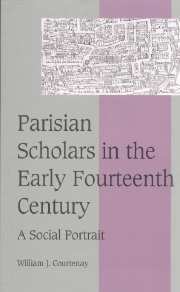Book contents
- Frontmatter
- Contents
- List of maps and figures
- Preface
- List of abbreviations
- INTRODUCTION: PARIS IN 1329
- Part I The recovery and context of a document
- 1 THE COMPUTUS OF 1329–1330
- 2 COLLECTAE AND UNIVERSITY FINANCE
- 3 PRECIPITATING EVENT: THE RAPE OF SYMONETTE
- Part II A window on a lost world
- Part III Biographical register
- Select bibliography
- Index of persons and places
- Subject index
- Cambridge Studies in Medieval Life and Thought Fourth series
3 - PRECIPITATING EVENT: THE RAPE OF SYMONETTE
Published online by Cambridge University Press: 17 August 2009
- Frontmatter
- Contents
- List of maps and figures
- Preface
- List of abbreviations
- INTRODUCTION: PARIS IN 1329
- Part I The recovery and context of a document
- 1 THE COMPUTUS OF 1329–1330
- 2 COLLECTAE AND UNIVERSITY FINANCE
- 3 PRECIPITATING EVENT: THE RAPE OF SYMONETTE
- Part II A window on a lost world
- Part III Biographical register
- Select bibliography
- Index of persons and places
- Subject index
- Cambridge Studies in Medieval Life and Thought Fourth series
Summary
Late in the summer of 1329 a student in the arts faculty at the university of Paris, Jean le Fourbeur (John the rascal or knave, a sobriquet he acquired or inherited), was arrested and imprisoned by the bishop of Paris on charges of raping a woman named Symonette. The alleged act had taken place somewhere in the diocese of Meaux immediately to the east of Paris, probably during the summer vacation when Jean was back in his home territory. Jean came from the village of Rozay-en-Brie, south of Meaux, and Symonette was a native of Bar-sur-Aube, to the east of Troyes on the southern edge of Champagne. Unfortunately, nothing more is known about the circumstances of the event except its aftermath: Jean returned to his studies at Paris and Symonette or her family followed him to seek justice, or perhaps to force him into marriage.
Jean le Fourbeur claimed to be innocent of the rape of Symonette and was released into the custody of his master, Milo de Jorello, in accordance with university privileges. At the time master Milo, who came from the diocese of Troyes, was living in the area of the rue de Garlande and rue d'Arras with five socii, one of whom may have been Jean le Fourbeur. Jean was soon seized and reimprisoned, presumably because he had by then been judged guilty, until he paid the substantial financial penalty that had been imposed by the bishop or his official: 400 pounds parisian
- Type
- Chapter
- Information
- Parisian Scholars in the Early Fourteenth CenturyA Social Portrait, pp. 49 - 56Publisher: Cambridge University PressPrint publication year: 1999



